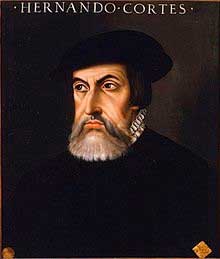News Flash: You can thank Cortez for the Beefsteak Tomato.
Remember Hernando Cortez? He’s the Spanish Conquistador you learned about in fifth grade who conquered Montezuma and decimated the massive Aztec Empire in Mexico back in the early 1500s. He and his soldiers arrived in Mexico, just a few years after the Columbus sailings. Cortez is not known as a really nice guy, especially after destroying one of the biggest and most advanced civilizations in the world. Read on for his one redeeming quality…
Tomatoes grow wild in Mexico, and the Spaniards had never seen them before. They became interested and were told of a “magic tomato” that was the largest and best. It seems a normal wild tomato produces just very small fruits, hardly worth picking. But the Aztecs told Cortez of a “great one” they had found years before growing in the wild, and they were now growing in large fields. Seeds from the original one grew into plants with the large tomatoes also, so it had become an important part of their highly developed agriculture, and a mainstay of their diet.

Well, when Cortez returned to Spain in glory in 1541, mostly he brought the fabulous, looted gold of the Aztecs. This made him famous and began the treasure fleets that sailed home to Spain for 300 years, making Spain the richest nation in the world. But he also took a few Beefsteak Tomatoes (No, the Aztecs didn’t call them that!) which created a sensation at the Spanish Court. And, literally, the rest is history. Of course it’s been hybridized scores of times, but it is still the most popular tomato worldwide.
Ever since Cortez took it home, botanists have tried and tried to discover why this tomato is so large, but also so delicious, and here’s the news: Brilliant American researchers discovered the secret just last year. It happened at the famous Cold Spring Harbor Laboratory on Long Island, NY.
It’s all about stem cells; yes, plants produce stem cells just as humans do, and the number of stem cells controls the size of seeds and fruits. Too many stem cells often create weak, short-lived overgrown plants, which is why plants and fruits are controlled by their steady, unchanging stem cell count. But sometimes, added stem cells create a masterpiece in nature. The beefsteak turned out to be sort of a “Goldilocks tomato” with stem cells—Not too few. Not too many. Just right.
Like everything in nature, there are exceptions, called mutations. And botanists have always known that new plants and flowers are not all created by hybridizers. Sometimes, rarely, of course, there are “natural hybrids” because of a climate change or other exceptional conditions where a plant or tree is growing. The same thing happens with stem cells—sometimes the standard stem cell count in a plant rises or falls. And that’s what happened in Mexico long before Cortez arrived. The large, delicious Beefsteak Tomato was created naturally, and found by the Aztecs. Purely by luck.
Cold Spring Harbor Laboratory is a private, non-profit institution formed back in 1890, and today, with over 1200 scientists and staff, spends most of its time and money on cancer research. It is a very famous place which has won multiple Nobel Prizes over the years.
Last year, Dr. Zachery Lippman, one of their well-known faculty members, working in the laboratory’s Plant Biology Department made the discovery of exactly how the beefsteak tomato happened. Think of it. It took us 476 years to figure it out. The full story of Dr. Lippmann’s discovery is quite detailed, but you can read it all here:
The Full Story from New Food Magazine.